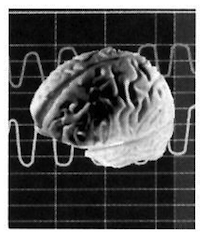Listening alongside His Holiness the Dalai Lama at a recent conference on meditation, I was inspired by the notion I was hearing that this century may be remembered less for its velvet revolutions than for the more obscure transformations that have softened the mechanized edges of medicine. Lately, new research areas bearing such names as “bio-individuality,” “psycho-neuroimmunology” and “the quantum theory of consciousness” have quietly appeared. To many scientists, these areas are independent of the groundbreaking revolution in relativity, which let physicists see matter as part waves and science as pan religion. But if quantum physics has taught us anything, it is that what appears to be continents actually may be just as cohesive as oceans. Some observers of science see such breakthroughs as a “wave revolution” that is shifting Western science toward the wisdom of Asian traditions. This shift appears in Herb Benson’s Transcendental Meditation-based “relaxation response,” aimed at healing the body by calming the mind; in Jon Kabat-Zinn’s vipassana-style “stress reduction” clinic, and in Ayurvedic “lifestyle therapy,” popularized by Dean Ornish.
 In recent decades mind-body medicine has used Asian self-healing science to help Western patients get back in the driver’s-education seat beside their doctors in our technologically driven “biomedicine” machine. As researchers continue to dissolve the mechanistic conventions of Western medicine, mind-body centers have become beacons of a new paradigm integrating “unconventional” methods with modern ones. The classical picture of DNA as a disease blueprint has become an impressionistic painting in which a collage of genes may blend to create “susceptibilities”; faith in one “quick fix” that would be targeted at unitary “mechanisms” of disease, a “magic bullet” capable of curing all patients, is pie in the sky now that we know how biologically unique people are; hopes of pinning diseases on purely mechanical causes like “germs” or “random mutation” have dissipated with the news that they depend more on immune response, which ebbs with the tide of mind-body stress states; computer models of mind as software and brain as hardware have faded into natural models of neural “networks” and “wetware,” in which consciousness-waves shape our dreamlike experience. Such breakthroughs not only inform mind-body methods but also recover the self-healing science and arts previously lost to the West by its exclusion or homeopathy, naturopathy, and other forms of the classical Eurasian traditions that thrive in India, China, and Tibet. The conference on meditation, held in New York City in May, jointly hosted by Tibet House, Beth Israel Hospital, and Columbia’s Center for Meditation and Healing, was itself a quiet “wave revolution.” The conference brought together many pioneers of modern revolutions in medicine, including Herb Spector, “father of psycho-neuroimmunology,” Rodolfo Uinas, clarifier of the “quantum of consciousness,” and Bruce McEwen, a leader in “positive health.”
In recent decades mind-body medicine has used Asian self-healing science to help Western patients get back in the driver’s-education seat beside their doctors in our technologically driven “biomedicine” machine. As researchers continue to dissolve the mechanistic conventions of Western medicine, mind-body centers have become beacons of a new paradigm integrating “unconventional” methods with modern ones. The classical picture of DNA as a disease blueprint has become an impressionistic painting in which a collage of genes may blend to create “susceptibilities”; faith in one “quick fix” that would be targeted at unitary “mechanisms” of disease, a “magic bullet” capable of curing all patients, is pie in the sky now that we know how biologically unique people are; hopes of pinning diseases on purely mechanical causes like “germs” or “random mutation” have dissipated with the news that they depend more on immune response, which ebbs with the tide of mind-body stress states; computer models of mind as software and brain as hardware have faded into natural models of neural “networks” and “wetware,” in which consciousness-waves shape our dreamlike experience. Such breakthroughs not only inform mind-body methods but also recover the self-healing science and arts previously lost to the West by its exclusion or homeopathy, naturopathy, and other forms of the classical Eurasian traditions that thrive in India, China, and Tibet. The conference on meditation, held in New York City in May, jointly hosted by Tibet House, Beth Israel Hospital, and Columbia’s Center for Meditation and Healing, was itself a quiet “wave revolution.” The conference brought together many pioneers of modern revolutions in medicine, including Herb Spector, “father of psycho-neuroimmunology,” Rodolfo Uinas, clarifier of the “quantum of consciousness,” and Bruce McEwen, a leader in “positive health.”
Robert Thurman’s keynote argued that science isn’t especially modern or Western; instead of debate, he received assent from biopsychologist Crawford Clark, who remarked, “We’re closer than I thought.” UCLA’s Roy Walford demonstrated how yogic diets promote longevity by showing slides of himself sealed in a “biosphere” looking as skinny as Tibet’s great yogi Milarepa. The Dalai Lama was visibly moved by a deathbed poem read by Beth Israel North Director Fred Epstein, and he greeted Dr. Epstein’s innovative work, which integrates high-tech medicine with humanistic care, as a parent would a missing child. In turn, the new integrative paradigm recognized its ancestral roots when Drs. Larry Scherwitz and Redford Williams targeted excess self-involvement and hostility as killers, confirming the two most basic prescriptions of the Buddhist tradition. As revolutions in modern science are linked to Asian meditation practices in the growth of mind-body medicine, Arnold Toynbee’s vision of a world renaissance sparked by the meeting of East and West seems to have arrived.
Thank you for subscribing to Tricycle! As a nonprofit, we depend on readers like you to keep Buddhist teachings and practices widely available.